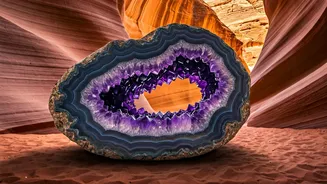Grand Canyon's Majesty
The Grand Canyon in Arizona is a breathtaking example of nature's artistry. Carved over millions of years by the Colorado River, this immense canyon stretches
over 277 miles long, up to 18 miles wide, and a mile deep. Its sheer size and the vibrant colors of the rock layers create a visual spectacle that's hard to forget. Visitors can hike down into the canyon, ride a mule, or simply admire the view from various vantage points along the rim. The sheer scale of the canyon, combined with the changing light throughout the day, offers an ever-evolving panorama that's a true marvel of the natural world. It is considered one of the seven natural wonders of the world, for good reason.
Monument Valley's Drama
Monument Valley, straddling the Utah-Arizona border, showcases iconic sandstone buttes that rise dramatically from the desert floor. These formations, sculpted by wind and weather over millennia, create a landscape that is instantly recognizable from countless Western movies. The valley is part of the Navajo Nation, and visitors can take guided tours to learn about the area's geological history and the cultural significance of the formations to the Navajo people. The vibrant red hue of the sand and the unique shapes of the buttes offer a stunning photographic opportunity, and the vastness of the landscape instills a sense of awe and wonder.
Yellowstone's Geysers
Yellowstone National Park is a geothermal wonderland located primarily in Wyoming. Known for its geysers, hot springs, and diverse wildlife, Yellowstone offers a unique natural experience. Old Faithful, the park's most famous geyser, erupts with remarkable predictability, providing a thrilling spectacle. Beyond the geysers, the park features colorful hot springs, mud pots, and a variety of animal species including bison, elk, and bears. The park's ecosystem is a delicate balance of natural forces, making it an excellent destination for those interested in science, nature, and wildlife conservation. The presence of these geothermal features also offers insights into the Earth's internal processes and the dynamic changes occurring beneath the surface.
Antelope Canyon's Light
Antelope Canyon in Arizona is a slot canyon renowned for its mesmerizing light and smooth, flowing sandstone walls. Carved by flash floods, the canyon's narrow passages and winding curves create a dramatic setting. Sunlight filtering into the canyon's depths gives the sandstone walls a vibrant glow, and the play of light and shadow is a photographer's dream. There are two primary sections to visit: Upper Antelope Canyon, known for its sunbeams that beam directly into the canyon, and Lower Antelope Canyon, which features more narrow passages and requires climbing several ladders to maneuver around. Guided tours are essential for safe entry, as flash floods are still a threat. Antelope Canyon is a testament to the power of nature and the beauty that can be found in unexpected places.
Hearst Castle's Grandeur
Hearst Castle, located on the California coast, is a stunning architectural marvel and a monument to opulence. Built by newspaper magnate William Randolph Hearst, this extravagant estate features lavish rooms, an expansive outdoor pool, and breathtaking views of the Pacific Ocean. The castle showcases a mix of architectural styles and houses a significant collection of art and antiques. Visitors can explore the estate through various tours, which offer a glimpse into the glamorous lifestyle of Hearst and his guests, including Hollywood celebrities. The castle is a time capsule of the roaring twenties and the grandeur of a bygone era. The property's beauty is only matched by its rich history, offering a truly immersive experience.
















